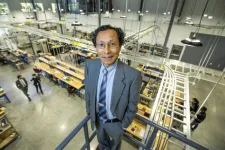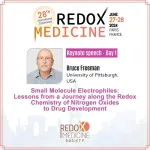CLEVELAND—About 32.5 million people in the United States and 500 million globally suffer from the degenerative joint disease known as osteoarthritis (OA), according to the Centers for Disease Control.
OA, in which tissues in the joint break down over time, is the most common type of arthritis—especially in older people. The usual treatments target pain-relief, often with prescription opioids or prosthetic surgery, such as knee and hip replacements.
Now, backed by an award from the Advanced Research Projects Agency for Health (ARPA-H), a federal agency within the U.S. Department of Health and Human Services, a research team led by Case Western Reserve University will begin work on engineering, growing and commercializing “live” replacement joints to treat this painfully debilitating disease. The award is part of ARPA-H’s Novel Innovations for Tissue Regeneration in Osteoarthritis (NITRO) program.
The contract will be issued in two phases: $20.4 million in the first phase, and, if certain milestones are met, $27.3 million in phase two.
As proposed, within five years, 40 patients would have knee replacements with “live joints,” or biocompatible bone and cartilage grown from human cells that can restore natural function to the joint. The goal is to “scale up” the technology to make the treatment available to patients commercially.
“We are honored to receive this significant ARPA-H award. It speaks to the strength of our research enterprise and our ability to innovate in ways that change lives,” said Case Western Reserve University President Eric W. Kaler. “Most of us know someone or have first-hand experience with degenerative joint disease. The potential treatment outcomes from this research could positively impact the quality of life for so many suffering with this disease.”
The award is for a project titled “OMEGA: Orchestrating Multifaceted Engineering for Growing Artificial Joints.” Lead researcher Ozan Akkus is the Kent Hale Smith Professor of Engineering and a professor of mechanical and aerospace engineering at the university’s Case School of Engineering (CSE). Akkus is also director of CSE’s Tissue Fabrication and Mechanobiology Lab.
The OMEGA team is a multi-center group led by Case Western Reserve and includes Colorado State University, The Ohio State University, Rice University and Washington State University. Other partners in the program include the Boston biotech firm Sapphiros AI Bio, University Hospitals Medical Center of Cleveland, the Louis Stokes Cleveland VA Medical Center, and Massachusetts General Hospital.
“The OMEGA team is a shining example of how the rich and vibrant health ecosystem in Cleveland enables us to collaborate with partners across the nation to address critical healthcare challenges and improve outcomes,” said Venkataramanan “Ragu” Balakrishnan, Charles H. Phipps Dean of the Case School of Engineering.
ARPA-H accelerates better health outcomes by supporting the development of high-impact solutions to society's most challenging health problems.
Transferring intellectual property from lab to commercial market
Standard treatment for OA patients offers neither a permanent fix nor a solution without negative repercussions.
In 2020, there were an estimated 1.5 million hip and knee replacements nationally—a number projected to increase about 11% annually to about 5 million procedures by 2040 with an aging population and increasing obesity, according to The Journal of Rheumatology.
Prosthetic implants have a short- to-medium-term life cycle, lasting about 20 years, requiring revision surgeries as the implants wear out. Hip- and knee-replacement patients are also limited to low-impact activities.
Opioids, the main treatment for 800,000 OA patients, can have negative societal costs, including lost productivity and even criminal-justice issues, according to the American College of Rheumatology. The disease also aggravates diabetes and obesity by impairing or limiting mobility.
Later this month, the OMEGA team will begin the project that aims to address issues surrounding OA treatment by developing new ways to help the human body repair its own joints.
“The mission,” said Michael Oakes, Case Western Reserve’s senior vice president for research and a professor at the CWRU School of Medicine, “is to address the failures and limitations of current treatments by developing a safe and effective living joint that lasts a lifetime in the patient’s body.”
The program focuses on replacement joints built from human cells. Phase one will involve creating a living joint. Phase two will be demonstrating the safety and effectiveness with animal models, followed by human clinical trials.
The result would be load-bearing “live” joints that reverse OA damage, provide lasting pain-relief, and fully restore joint function. The goal is to commercialize their availability by 2029, and to do so in ways that improve patient access to new technologies and reduce health costs.
“It is an honor to lead an elite group of scientists and clinicians, integrating their vast expertise to regenerate the knee joint, the most complex joint in the human body,” Akkus said. “ARPA-H’s support gives the OMEGA team a fair chance to make the live joint a reality—not only as a working concept, but as a technology that will be commercially viable to benefit all segments of the society equitably.”
###
Case Western Reserve University is one of the country's leading private research institutions. Located in Cleveland, we offer a unique combination of forward-thinking educational opportunities in an inspiring cultural setting. Our leading-edge faculty engage in teaching and research in a collaborative, hands-on environment. Our nationally recognized programs include arts and sciences, dental medicine, engineering, law, management, medicine, nursing and social work. About 6,200 undergraduate and 6,100 graduate students comprise our student body. Visit case.edu to see how Case Western Reserve thinks beyond the possible.
END





